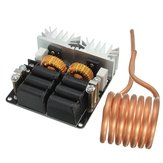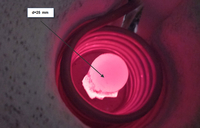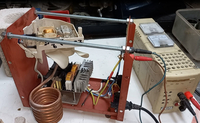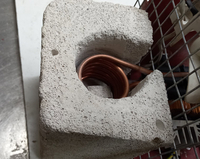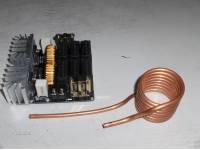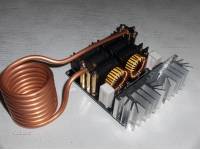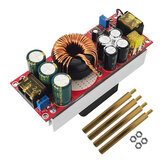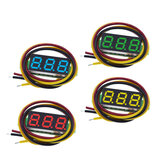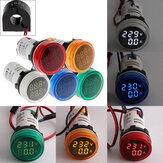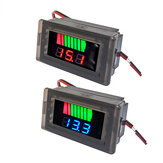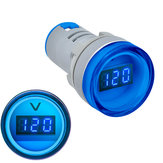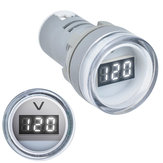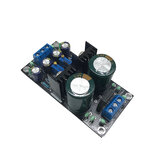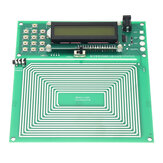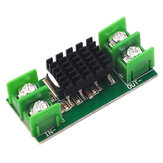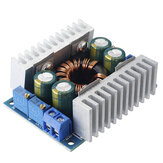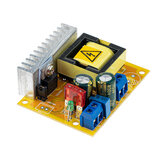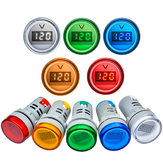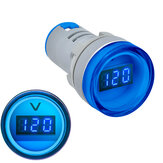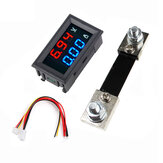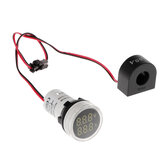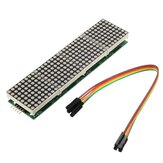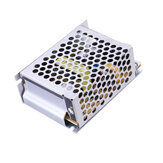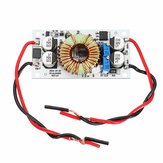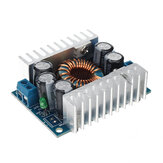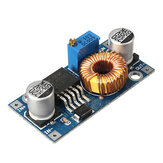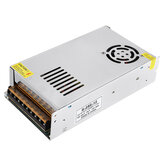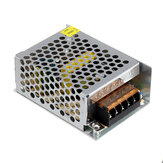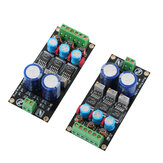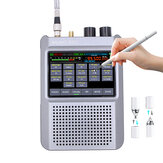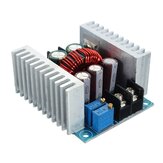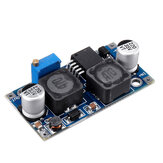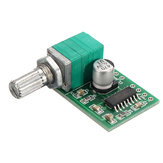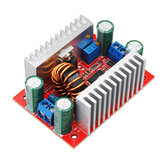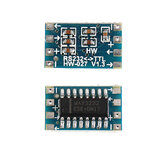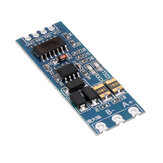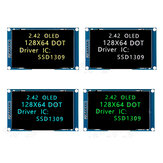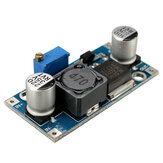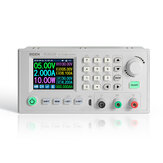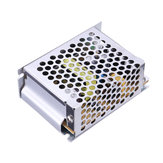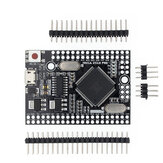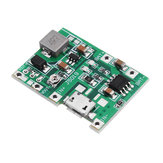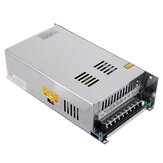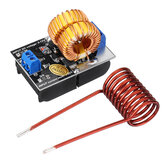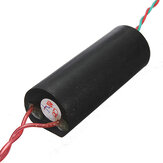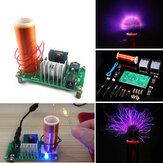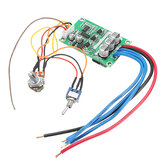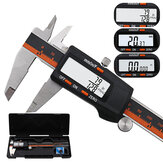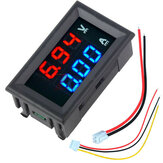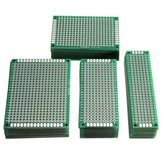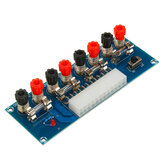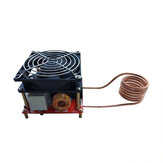Module de chauffage par induction haute fréquence Geekcreit® Low ZVS 12-48V 20A 1000W
Avis des clients
- Tous les Commentaires (261)
- Image (25)
- Vidéo (0)
Une partie de la critique a été traduite automatiquement.
-
 mannuVIP3RO15/08/2017
mannuVIP3RO15/08/2017It is an impressive induction heater working at 85 kHz frequency. I have added a little improvements : cooper contact for coil, a fan cooler and refractory sponge-brick as coil / crucible support. I have tested with a switching power supply with DC output of 24V /20A using a graphite crucible (33mm diameter and 30mm height); the current was aprox. 18A and the crucible has reach 900C in 3-4 minutes; first i have start the power supply then i have connected the induction heater. i recommend this induction heater.
CommentairesAfficher l'original -
26/03/2016
Coil ID 1.700", OD ~2.160. Board (overall, including heat sinks) 4.400" x 3.950" x 1.520". All dims are approximate and rounded up to the next number that made any sense. Input voltage is marked for polarity (- terminal only) but neither voltage nor amperage are labeled. Again, like with the smaller unit, if you were hoping to receive some sort of documentation, you are out of luck. The copper tubing is not insulated so, despite the generous size of the coil, the electrical path will be quite short with the whole coil acting as if there is only a 1/8th turn unless you make the effort to isolate the tubing yourself. I've made no attempt to power this up yet, so all I can pass along are the physical attributes.
Commentaires (2)Afficher l'original -
16/09/2022
Très ggod appareil. Le secret est que vous avez besoin d'une grande alimentation. D'abord j'ai utilisé un ps maison de deux transformateurs de four à micro-ondes 40 v 25 A. Plus tard, j'ai utilisé un ps d'un transformateur 25 v et beaucoup de nombreux ampères d'une machine de cinéma de 1970 s. J'ai réussi à obtenir rouge un morceau de fer d'un diamètre de 25 mm en 90 sec. Un bon courant est 20-32 V 15 A. N'utilisez pas plus de 20 A pendant beaucoup de temps pour ne pas brûler les mosfets. L'induction commence après 12 v.J'ai utilisé un ventilateur d'un four à micro-ondes pour garder le dissipateur de chaleur du mosfet frais. Dans le grand ps j'ai utilisé un redresseur 35 A bridgfe avec grand dissipateur thermique et afan de l'ordinateur (12 v).Don' mettre des articles avec plus de 3 cm de diamètre et plus de 4-5 cm de long pour garder les amplis moins de 20.Si vous utilisez un régulateur de tension avec triac sur le primaire du transformateur la tension doit être supérieure à 150 v pour ne pas brûler le pont.Il est préférable d'utiliser un variac pour avoir toujours une onde sinusoïdale complète dans chaque tension dont vous avez besoin.
Commentaires (2)Afficher l'original -
26/11/2016
Szybka wysyłka, szybko grzeje, na zdjęciu zasilacze serwerowe do zasilania. Przy większych mocach potrzebny wiatrak chłodzący i chłodzenie wodą. Polecam.
CommentairesAfficher l'original -
 C4WRCFR29/03/2018
C4WRCFR29/03/2018Voici un petit système de chauffage à induction très compact et pratique qui va m'être très utile pour mes bricolages, il me reste a lui faire un boitier
CommentairesAfficher l'original -
17/12/2016
This very functional inductive heater has become a hot item. You can do many things with this system. Because of high current/stability. best to use 4 X 12 VDC leadgel batteries of minimal 12 AH (better 17AH) IN SERIE to feed this system Use one of the batteries to power a fan for the electronic parts too. Switshing powersupplies are less /not suitable, the fast slope of the drained current can interfere / not starting oscillation. So be wise , use as alternative a 1KW 35VAC ringwound trafo, rectifiers and a lot of switshingproof elco's in parallel. A Variac can be used but start up in full mode and than reduce voltage. When cooling s OK and powersupply is sufficient the only big problem is to start the oscillationprocess (It is self oscillating). !000Watt is quite a lot, the smaller ones I have bought first are already nasty heaters wich can heat up a nail in seconds.
Commentaires (1)Afficher l'original -
27/12/2021
Le produit est de très mauvaise qualité. Transistors sur les radiateurs de refroidissement sans composé thermique, un transistor ne s'adapte pas du tout au radiateur de refroidissement. Une extrémité de l'enroulement du drosel n'est pas soudée du tout dans la planche. Lors de l'allumage sur le mode épargne zadraschiem transistor.Ocht une très mauvaise impression du produit.
CommentairesAfficher l'original -
 tokrzychVIP1PL02/06/2017
tokrzychVIP1PL02/06/2017Nagrzewnica działa dobrze , wymaga chłodzenia przy dłuższej pracy. Kiedy mam już podpięte zasilanie pod zasilacz i włączam go to nagrzewnica nie startuje za każdym razem . Ale jak podpinam przewód zasilający do włączonego już zasilacza to działa od razu OK . Widocznie powolny czas narastania napięcia przeszkadza w pewnym starcie nagrzewnicy.Tu na zdjęciu tak na próbę dałem 28v i 5,7A ,4mm gwoźdź się rozgrzał w jakieś 20-25s. Na luzie pobiera w tym momencie 28v i 3,6A . Dzisiaj przyszła więc to takie pierwsze uruchomienie
Commentaires (1)Afficher l'original -
 igortVIP2CA14/04/2016
igortVIP2CA14/04/2016Used the heater to silver braze a very small SS tube to a much larger SS part. This was a problem with a torch since the parts were so dissimilar in size. The heating with the induction heater was very uniform and did an excellent job. Overheating of the flux was a problem with the torch, but not with the induction heater. Heating cycle was about 2.5 minutes.
CommentairesAfficher l'original -
05/04/2018
Estoy haciendo unos experimentos, usando el circuito Geekcreit ZVS dentro de otro ideado por Tesla. Ya os contaré como me fue. Creo que con este circuito resuena con intensidad suficiente para hacer funcionar el circuito diseñado por Nikola Tesla. la Patente 685.957 : Método de utilización de la Energía Radiante la Patente 512.340 donde una genialidad de Nikola: la Bobina Bifilar tiene la clave de la resonancia armónica, es como condensador de flujo electro-plasmático, capaz de enfriar la energía de la Red Eléctrica: separar magnetismo y electricidad, resultando que el coseno de Phi de la energía consumida tiende a 0 significa que podemos ahorrar en consumo un 100 % y tener una nueva forma de energía eléctrica fresca, no peligrosa, saludable y natural.
CommentairesAfficher l'original
